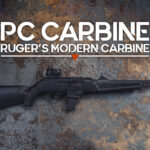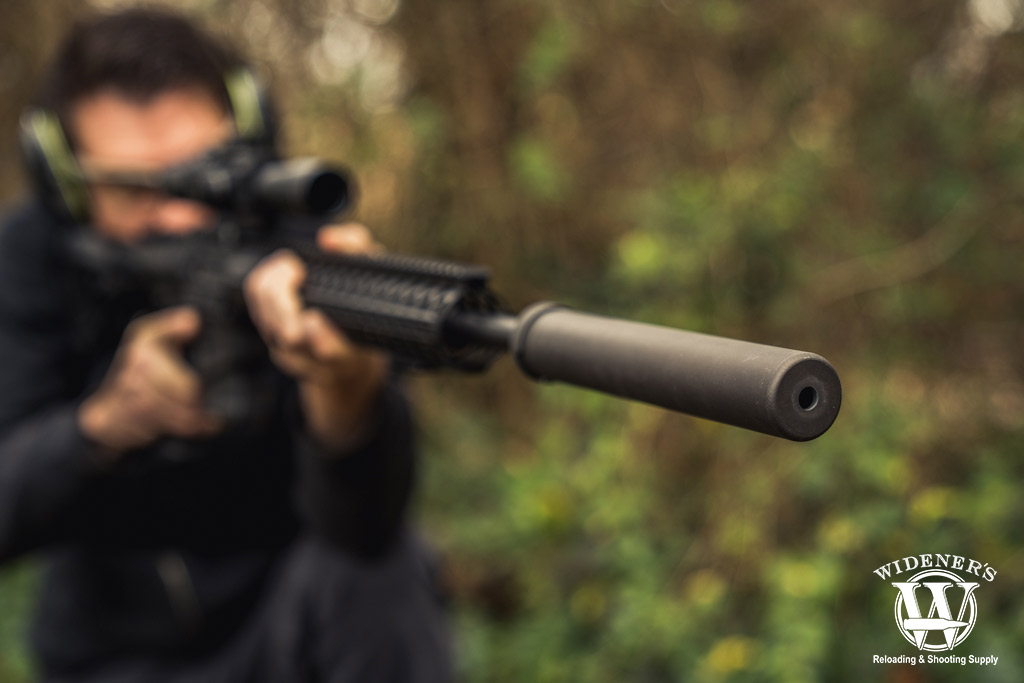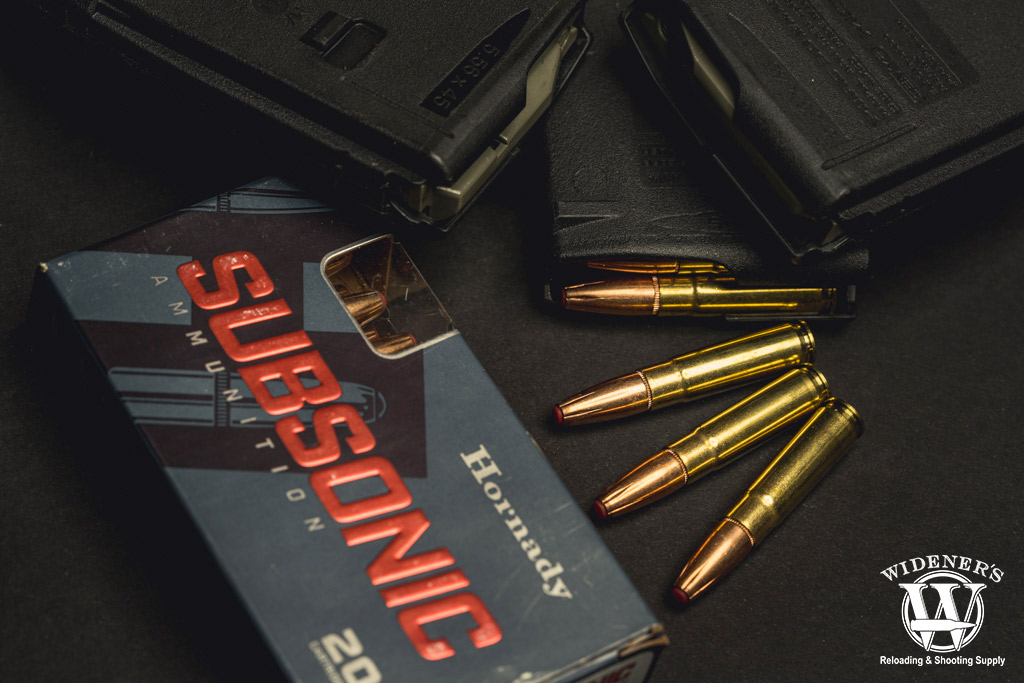

By Guy J. Sagi
There are a variety of reasons subsonic ammunition is growing in popularity, and reduced noise is only one of them. Many enthusiasts have discovered improved accuracy with loads that don’t break the sound barrier, reduced recoil and faster follow-up shots. Membership among the nearly 2 million people in the United States who own a suppressor isn’t mandatory, either.
Physics explains the advantages, and compromises. It’s a subject that lends itself to lengthy scientific discussion, but we’ll spare you the pain with the principle abbreviated in practical terms.
Slower Than Sound

When shooting suppressed, gun owners can take full advantage of the benefits of subsonic ammo.
Simply put, subsonic cartridges launch bullets from a firearm muzzle at a velocity below the speed of sound. Manufacturers accomplish the task by reducing the amount or type of propellant in the case, using a heavier projectile, or in many cases a combination thereof.
It’s not quite as simple as it sounds, because barrels vary in length and velocity nearly always increases with that distance. There’s also the challenge of operation in semi-automatic firearms. They require generation of a minimum amount of energy with each shot to reliably cycle the slide, bolt or bolt carrier group. The balancing act accomplished by companies and the effectiveness of their loads is nothing short of amazing, particularly in .300 Blackout loads tailored for ARs and 9mm ammo for handguns.
Subsonic Ammo Speed Limit
Sound travels, on average, somewhere around 1,125 feet per second (fps) through the air. It’s faster through water and solid materials.
That speed, however, is not constant. Environmental factors affect the precise velocity, particularly temperature. It’s faster in hot weather than in the cold.
Thankfully, manufacturers of subsonic ammo address real-world velocity swings—which are small, anyway—by staying comfortably below Mother Nature’s variable speed limit. At 32 degrees Fahrenheit sound travels roughly 1,086 fps, and loads labeled as subsonic usually run at or below 1,050 fps.
Why Go Slow?

Subsonic ammunition eliminates the shockwave “crack” of high-velocity ammunition breaking the sound barrier.
Fighter aircraft illustrate the most recognizable advantage of not exceeding the speed of sound. When planes accelerate past this called “sound barrier” it creates a sonic boom of teeth-rattling proportions, if you’re close enough.
Bullets do the same thing, but their smaller size diminishes the noise’s magnitude. That characteristic “crack” sound that’s so familiar to shooters is the projectile surpassing sound’s velocity. With or without a suppressor, subsonic ammunition is easier on the ears and more neighbor-friendly than a high-velocity round in the same chambering.
The effect is significant and particularly noticeable in .22 rimfire loads. It’s a great advantage for small-game hunters and property owners trying to deal with unwanted vermin.
Olympic Subsonic Precision
There are more than a dozen Olympic sports that require competitors to use a firearm. Scores are fully or partially based on accuracy; precisely why subsonic ammo dominates pistol and rifle matches. Despite the fact .22 rimfires hold a near-exclusive on the prestigious events, the forces at work—or more precisely not at work—apply to centerfire cartridges.
In-flight projectiles experience surface pressure at a variety of locations (not just the nose) and ballisticians work hard to streamline that drag to increase downrange performance. But, when a bullet approaches the speed of sound and the sonic boom begins, it generates unpredictable turbulence that can alter its course slightly. If so, it results in poor groups on target.
Engineers have made great strides in minimizing inconsistencies created as bullets go transonic. Improved bullet coefficients and concentricity handle much of it, but the pressure that affects stability still exists on any projectile (or jet) when it swings past 767 miles an hour. As a result, when precision counts in international competition, shooters on the leader-board go slow.
Subsonic Bullet Weight

Manufacturers like Hornady produce subsonic bullet options in popular calibers like .223 Rem and 300 Blackout.
There’s another factor at play that often improves subsonic ammo’s performance downrange. Manufacturers go with heavier bullets as part of their subsonic cartridge design, and because the diameter must remain bore size, the projectile winds up longer.
The result is a streamlined profile that doesn’t bleed energy as quickly during flight. That improved ballistic coefficient often shows in retained downrange energy, too, a critical consideration for hunters.
Figures published by Hornady illustrate the effect. The company’s American Gunner .223 Rem. with 55-grain HPs leave the muzzle at a scalding 3,240 fps carrying 1,282 foot-pounds of energy. The company’s 190-grain Sub X load for .300 Blackout, by comparison, seems to lumber out of the barrel at 1,050 fps. That figure indicates it has 465 foot-pounds of energy at departure.
The story’s different at 500 yards, thanks to the longer and heavier bullet’s improved ballistic coefficient. At that distance, the .300 Blackout bullet has retained more than 80 percent of its velocity—traveling 856 fps. The .223 Rem. round surrendered speed, but it’s still faster at 1,426 fps.
Retained energy is another story. The .300 blackout is the clear winner with 309 foot pounds, compared to the .223s total of 248. Both figures are far from ideal for big game at that distance, but they demonstrate another, often overlooked, advantage with subsonic.
There’s also an advantage on those unpredictably breezy days. A heavier projectile, on average, is less affected by wind.
Reduced Recoil
Although manufacturers typically increase bullet weight to generate enough energy to run in semi-automatic firearms, subsonic loads usually produce less recoil. For new enthusiasts eager to avoid developing a flinch it’s a big advantage, one enhanced with noise reduction.
Less recoil also minimizes muzzle rise with each shot. If a follow-up shot is necessary, getting back on target is faster and easier.
Subsonic Bullet Considerations
Regardless of the energy .300 Blackouts maintain downrange, many experts caution 100 yards is about the limit for hunters pursuing big game. Most sportsmen fill their tags in that distance or closer, anyway. Pushing subsonic ammo much further risks wounding the animal. Effective range can stretch for feral hogs, predators and other vermin.
Bear in mind, too, bullets work best when they impact within a certain window of velocities. A hollow point at too low or high of a speed can fail to expand, or even lose its integrity, when it hits a target. It’s a critical consideration for hunting and home defense. Not all bullets like to go slow.
What About Suppressed Handguns?

Feeling subsonic? The grain weight of the standard .45 ACP bullet makes it an excellent subsonic round.
Rimfires and rifles aren’t the exclusive realms of subsonic loads, either. More and more manufacturers are offering 9mm versions in a variety of grain weights that, although ideal for enthusiasts with matching suppressors, offer big advantages to all users. Find the right load, with the right bullet, and even without a “can” the sidearm’s bark and recoil “bite” quiet.
The easiest handgun caliber to run suppressed is the beefy .45 ACP. The weight of the standard 230gr bullet slows the velocity down to subsonic levels below 1,125 feet per second. There’s no shortage of handguns chambered in .45 ACP on the market, and finding a threaded barrel option is as easy as two clicks of the mouse online.
Subsonic ammo isn’t a recent innovation, although it’s been rediscovered by all-new generation of gun owners. Manufacturers responded with improvements in design and performance, making it some of the most versatile ammunition on the market today.


